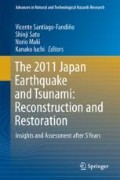Abstract
The author defines post-disaster as the process of restoring survivors’ living and enhancing the sustainability and resilience of the built environment. It thus appear that close attention must be paid to transformation of built environment which is formed by aggregation of human habitation and housing reconstruction. What became visible after 5 years since tsunami is that individual relocation actions and collective resettlement policy lead to “polarization” between mountainside new residential area and lowland tsunami-affected area, the latter still remain checkerboard housing recovery situation even if the area are outside of hazardous zone, in which new residential building is restricted. Increase of unmanaged vacant properties and its scattered distribution destroys their built environment and community, and gives negative influence for people who decided in-situ housing reconstruction. Local government recovery planning in Tohoku is too limited to tsunami risk reduction such as land raising and collective relocation by redevelopment projects, but lacks planning technique in repopulating and regenerating neighborhoods with “spatial and temporal continuity” between pre-disaster and post-disaster. One of the alternative planning method is “collaborative planning and management” that go beyond government-driven redevelopment project which utilizes and coordinating residents’ motivation to regenerate housing stock and land use management in their neighborhoods. Planning should not ignore peoples’ resilience to improve their built environment and private sector’s vitality in pre-disaster recovery planning with a sense of economic rationality which retain continuity between normal and catastrophe.
Access this chapter
Tax calculation will be finalised at checkout
Purchases are for personal use only
References
Aiba S (2015) Fold up the city. Kabunsha (in Japanese)
Amaratunga D, Haigh R (2011) Post-disaster reconstruction of the built environment. Wiley Blackwell, Oxford
FDMA – Fire and Disaster Management Agency (2011) Official record on the 2011 Great East Japan Earthquake 2011. Ministry of Internal Affairs and Communications. (in Japanese) http://www.fdma.go.jp. Accessed Sept 2016
GSI – Geospatial Information Authority of Japan (2011) Official record on tsunami inundation by the 2011 Great East Japan Earthquake, 2011 (in Japanese). http://www.gsi.go.jp. Accessed Sept 2016
Iuchi K, Elizabeth M, Johnson L (2015) Three years after a mega-disaster: recovery policies, programs and implementation after the Great East Japan Earthquake. In: Santiago-Fandiño V et al (eds) Post-tsunami hazard-reconstruction and restoration. Springer, London, pp 29–46
Iwate NIPPOU (2014) January 22th 2014 (in Japanese)
Kondo T (2016a) Compensation of assistance? Law and policy for post-disaster housing recovery in the U.S and Japan. In: Kaneko Y et al (eds) Asian law in disaster. Routledge, London, pp 178–187
Kondo T (2016b) Spatial characteristics and impact on built environment regeneration by property transfer and regeneration programs after Hurricane Katrina. J Archit Plann 82(733):715–721 (in Japanese)
Kondo T, Karatani Y (2016) Spatial planning for housing recovery after the Great East Japan Earthquake. In: Greiving S et al (eds) Spatial planning and resilience following disasters: international and comparative perspectives. Policy Press, Bristol, pp 39–52
Otsuchi-cho (2016) Planning direction for Inner city regeneration. http://www.town.otsuchi.iwate.jp/gyosei/docs/2016070100012/files/280704houkousei.pdf downloaded on July 2016 (in Japanese)
Mano H (2013) Challenging planning technique “housing recovery” In: Hirayama et al (ed). 2013.11, pp 125–140 (in Japanese)
MIAC – Ministry of Internal Affairs and Communications (2010) Census 2010 and 2015. http://www.stat.go.jp/english/data/kokusei/2010/summary.htm http://www.stat.go.jp/english/data/kokusei/index.htm. Accessed Sept 2016
Masterson HJ, Peacock WG Van Zandt SS, Grover H, Schwarz LF Cooper JT (2014) Planning for community resilience. Island Press, Washington, DC. ISBN 9781610915854
School of Public Policy Tohoku University (2016) A study of law on post-disaster recovery planning after the Great East Japan Earthquake http://www.publicpolicy.law.tohoku.ac.jp/about/hyoka/workshop/2015/a.pdf. Accessed 12 Aug 2016
Schwab JD (2014) Planning for post-disaster recovery: next generation. American Planning Association Press, Chicago
Smith GP, Wenger D (2006) Sustainable disaster recovery: operationalizing an existing agenda. In: Rodriguez H, Quarantelli EL, Dynes RR (ed) Handbook of disaster research. Springer, New York, ISBN: 978-0-387-73952-6
The Japan Times (2015) Rikuzentakata looks to future with new tourism ventures, March 7th 2015. http://www.japantimes.co.jp/life/2015/03/07/travel/rikuzentakata-looks-future-new-tourism-ventures
Ubaura M (2016) Reconstruction plans and planning processes after the Great East Japan Earthquake, Spatial Planning and resilience following disasters: international and comparative perspectives. In: Greiving S, Ubaura M Tešliar J (eds) Policy Press, University of Bristol, Chicago, ISBN 978-1447323587
Author information
Authors and Affiliations
Corresponding author
Editor information
Editors and Affiliations
Rights and permissions
Copyright information
© 2018 Springer International Publishing AG
About this chapter
Cite this chapter
Kondo, T. (2018). Planning Challenges for Housing and Built Environment Recovery After the Great East Japan Earthquake: Collaborative Planning and Management Go Beyond Government-Driven Redevelopment Projects. In: Santiago-Fandiño, V., Sato, S., Maki, N., Iuchi, K. (eds) The 2011 Japan Earthquake and Tsunami: Reconstruction and Restoration. Advances in Natural and Technological Hazards Research, vol 47. Springer, Cham. https://doi.org/10.1007/978-3-319-58691-5_10
Download citation
DOI: https://doi.org/10.1007/978-3-319-58691-5_10
Published:
Publisher Name: Springer, Cham
Print ISBN: 978-3-319-58690-8
Online ISBN: 978-3-319-58691-5
eBook Packages: Earth and Environmental ScienceEarth and Environmental Science (R0)

